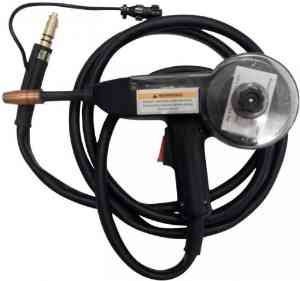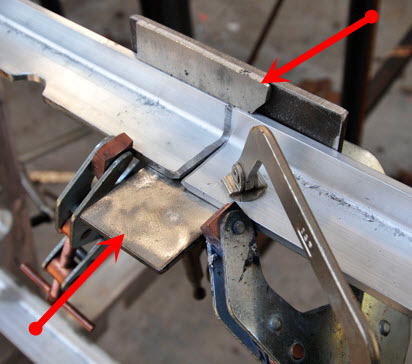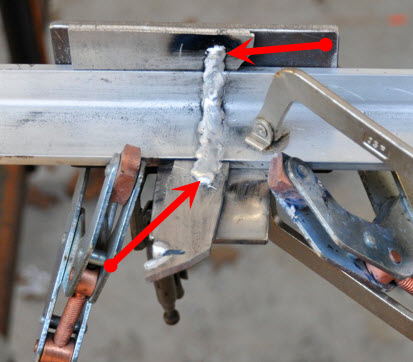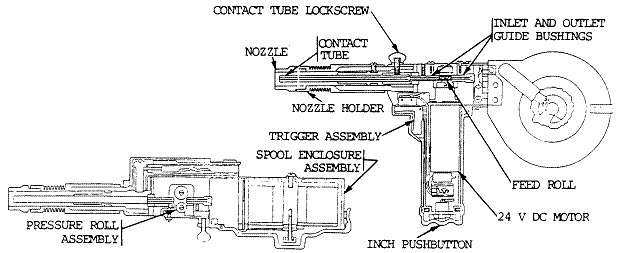About The MIG Welder Spool Gun!
Most welders prefer a spool gun to weld aluminum or they use it to run small diameter wire.
See, small wire will jam up in your hose very easily. Also, aluminum wire is soft which jams up in long hoses as well.
A spool welding gun has the wire on a spool inside the gun so that it does not run all the way through your hose which can easily jam.
Typically the handle of the gun has a motor that pulls out the wire electrode from the spool which is on the back of the gun.
Welding Aluminum Without A Spool Gun:
If your welder does not have the ability to attach a spool gun, or if you can't afford one, the only thing you can do is feed aluminum mig wire through the machine just like steel. If you do this keep in mind you will have better success if you use a Teflon liner with an aluminum feeding kit. Also keep the gun as short and as straight as possible. Do not coil it up on the ground or around the machine.
Also the gun is directly linked to the welder and the gas so you have everything in your hand:
the drive roll, the wire, and the shielding gas. Unlike a regular torch you have the wire feeding from the drive roll, into the hose, and into the torch.
Welding Aluminum With A Spool Gun!
To mig weld aluminum you need to use this type of gun. There are some who run wire through the hose and weld with a regular torch, but it's not easy. What they did was shorten the hose to reduce the chance of the wire jamming up. But it till has a good chance of jamming up because aluminum is soft.
So why risk it? Use a spool welding gun to mig weld aluminum. It's much easier. You might like it so much you'll use it to weld steel frequently.
Spool Gun Welding Tips and Techniques!
- Be sure the aluminum wire is clean.
- Wire stick out can be about .5 inches when you strike your arc.
- A common way to strike the arc is to strike it about one inch before the spot where you will start your weld, and right after you strike the arc bring it to the spot where you will begin the weld. You can also strike the arc on a runnoff tab (see below).
- Cratering and cracking is an issue when mig welding aluminum. Some welders like to reverse the direction of travel and at the same time increase their speed. This has the affect of making the weld puddle smaller or thinner (tapering) right before they stop welding and extinguishing the arc.
- You can also use a runoff tab. A runoff tab is a piece of the metal that is added to the base metal and tacked on to the end of where you will be welding. This way you can 'runnoff' the end of your weld onto the runnoff tab where you can break the arc without worrying about cratering. The runnoff metal can be any scrap piece of metal that is the same as the base metal. If there is a groove to weld then it should have the same groove as the metal you are welding. Run-off tabs are tacked onto the end of the workpiece to allow the welder to extinguish the arc without forming a crater on the workpiece.
Runnoff Tabs Clamped Into Place!
No Cratering After Breaking The Arc on Runnoff Tabs!
The images above were courtesy of Odyssey Yachts.
- Try an eighty degree angle when you weld. The most commonly used angle is anywhere from 70-85 degrees.
- Keep your welding speed consistent to the end of your weld.
- Use a stringer bead. If you need to cover a wider area avoid the weave technique and lay another stringer bead instead. You can weave but string beads are better when welding aluminum because you want to weld as fast as possible while maintaining good penetration and fusion.
- When you weld aluminum your amperage and voltage settings will be turned up. It will be hot. So you need to have a faster spool gun travel speed. If you are too slow you will probably burn through your material.
- If you are welding aluminum that is the same thickness, your work angle should be the same on both sides of your bead.
- If you are in the horizontal welding position you will find that you'll get better welds when you point your welding torch up at a slight angle.
- If you are going to weld thicker aluminum and thinner aluminum you should angle the arc thicker piece of metal.
- You may find the backhand welding technique is good for welding thin aluminum to thicker aluminum with a spool gun.
- If you are going to do a root pass on a joint you will need to maintain a shorter arc. A shorter arc when performing a root pass on aluminum will give you the penetration you need. But you can use a longer arc on your next passes.
Top 3 MIG Welders With Spool Guns!
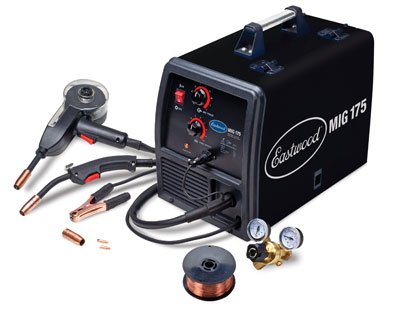
The Best 220V MIG Welder With A Gun:
The best mig welder that comes with a spool gun in terms of price and quality and works on a 220v outlet is the Eastwood 175. The Eastwood 175 MIG Welder is a solid low priced welder that also comes with a good spool gun for welding aluminum. The total price for this welder and the gun is under $550! That is really amazing.
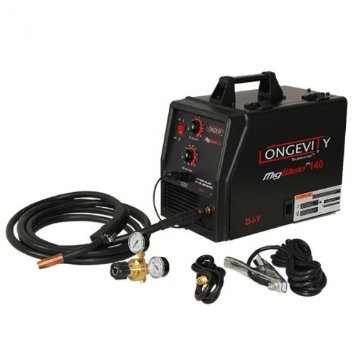
The Best 110V MIG Welder and Gun:
The best low priced mig welder that comes spool gun ready and works on a 110v outlet is the Longevity 140. You can get the Longevity 140 for just over $400, and you can buy a good spool gun for it under $200. You can get both for well under $600.
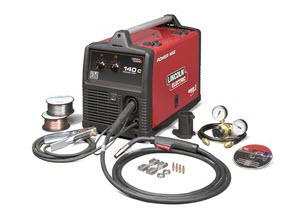
The Best Name Brand MIG Welder and Gun:
If price is not a big issue and you just want a name brand, high quality mig welder with the best dam spool gun for it, and you want it to run on 110v or 120v outlet, then go with the Lincoln 140c and the Magnum Gun. You will be very happy.
You get the Lincoln name, a fair price, and a good quality set up for MIG welding steel and MIG welding aluminum.
Inside A Gun:
Copyright WcWelding.com All Rights Reserved.
Welding Plans:
New! Welding Table
New! Log Splitter
Top Projects:
